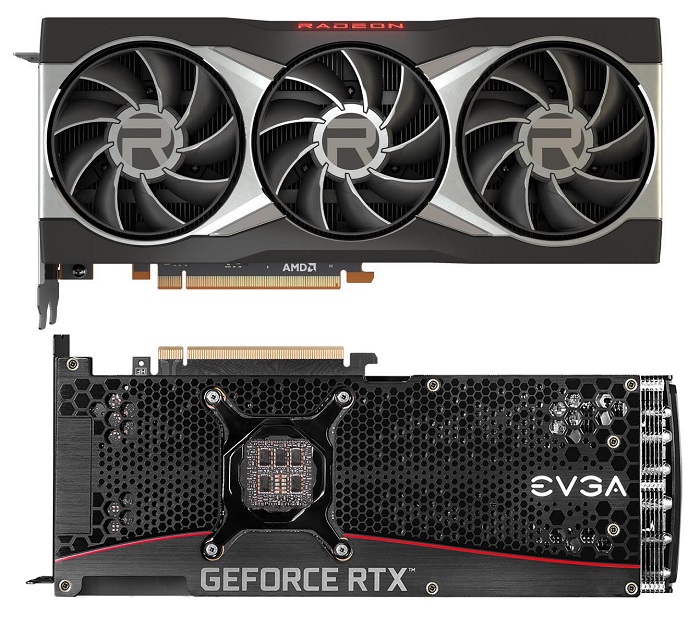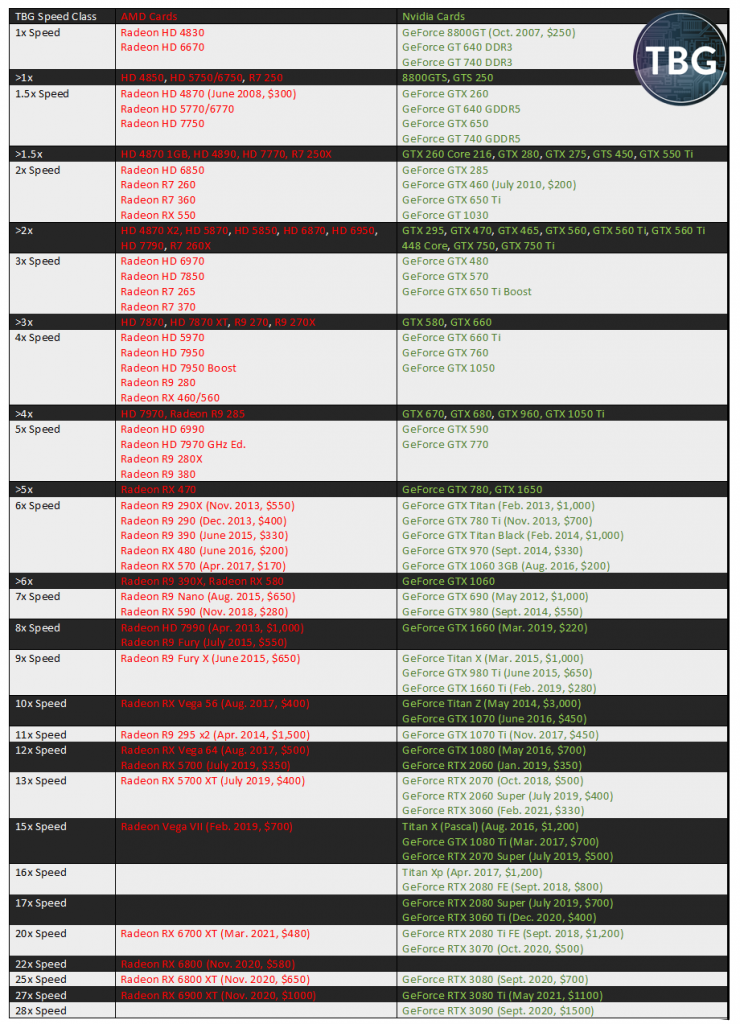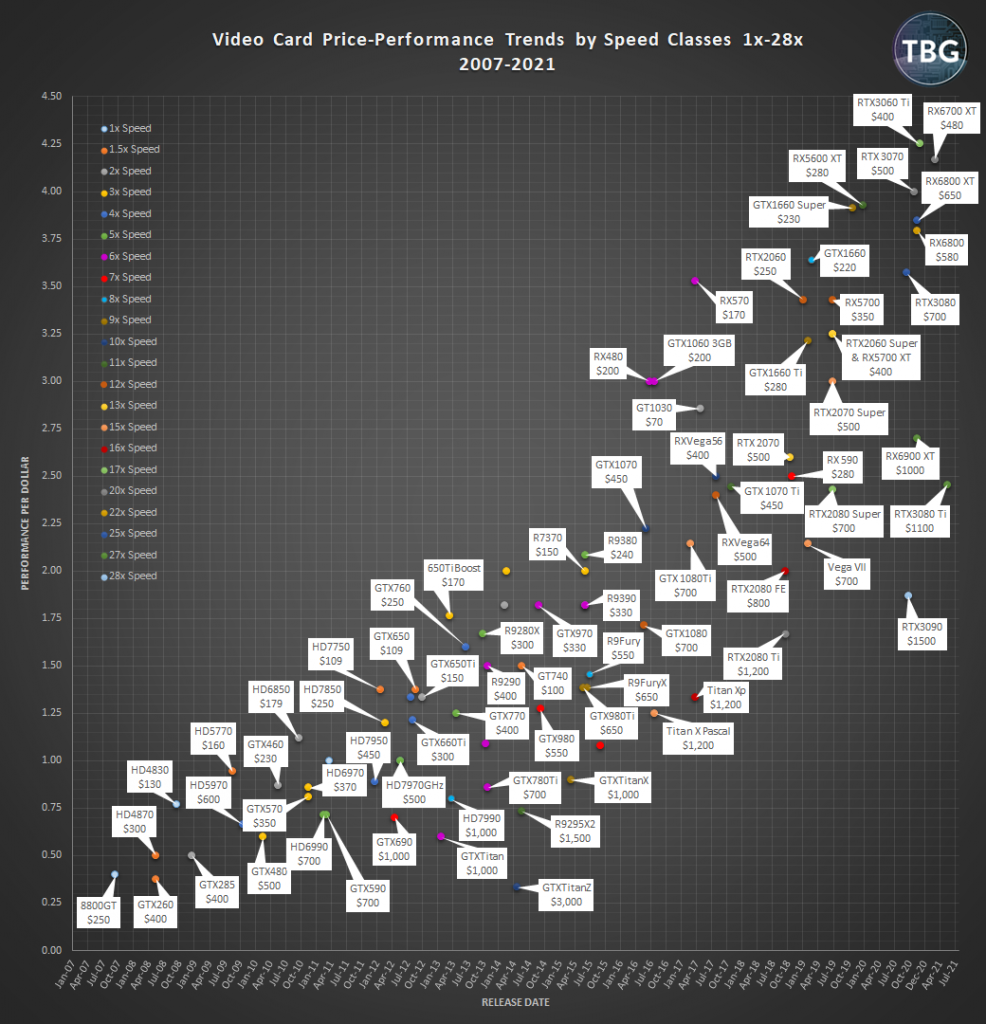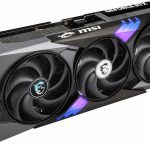The Video Card Rankings (2021)
Introduction
 To keep your PC up-to-date, you need to upgrade a few components here and there over time, and for gamers, the very best upgrade you can make is a new video card. That’s because they offer by far the biggest benefit in terms of a raw performance increase, and just about anyone can install one. But with the frequent product releases, refreshes, and outright re-brandings, how’s a PC user supposed to know what the best upgrade option is? Ask The Tech Buyer’s Guru, of course! To help our readers out, we’ve created this guide, which we update on an annual basis, generally following a major product launch from either Nvidia or AMD (or as is the case in late-2020 and early-2021, a complete revamp of the product stack by both companies!). We list nearly every GPU model released since 2007, ranking them using our proprietary “Speed Rating” system, which starts at a baseline “1x” Speed Rating, represented by the venerable Nvidia GeForce 8800GT. As of Spring 2021, there’s a video card that goes all the way to 28x, the $1,500+ GeForce RTX 3090, based on Nvidia’s latest “Ampere” architecture. It was released in September 2020, and will likely remain the fastest video card on the market for at least another year….
To keep your PC up-to-date, you need to upgrade a few components here and there over time, and for gamers, the very best upgrade you can make is a new video card. That’s because they offer by far the biggest benefit in terms of a raw performance increase, and just about anyone can install one. But with the frequent product releases, refreshes, and outright re-brandings, how’s a PC user supposed to know what the best upgrade option is? Ask The Tech Buyer’s Guru, of course! To help our readers out, we’ve created this guide, which we update on an annual basis, generally following a major product launch from either Nvidia or AMD (or as is the case in late-2020 and early-2021, a complete revamp of the product stack by both companies!). We list nearly every GPU model released since 2007, ranking them using our proprietary “Speed Rating” system, which starts at a baseline “1x” Speed Rating, represented by the venerable Nvidia GeForce 8800GT. As of Spring 2021, there’s a video card that goes all the way to 28x, the $1,500+ GeForce RTX 3090, based on Nvidia’s latest “Ampere” architecture. It was released in September 2020, and will likely remain the fastest video card on the market for at least another year….
Which brings us to the current state of the GPU market. Due to production problems, tremendous demand, arguably overly-competitive launch prices, and of course the most overwhelming cryptocurrency craze in history, well, gaming GPUs have practically gone extinct, at least when it comes to using them for you know, gaming. So our current video card ranking is basically a forward-looking document (or backward-looking, depending on how pessimistic you are about the return of normalcy in the GPU market).
Note that we don’t necessarily recommend all the cards in our rankings – the purpose here is to map out the video cards currently on the market and their relative performance per dollar ratios. If you’d like to know which video cards are actually worth buying, just flip over to our Video Card Buyer’s Guide, which is updated quarterly. It provides recommendations on the best products for the money at every pricepoint.
The Rankings
We determine the Speed Ratings of each card based on both our own testing of dozens of cards over the years, along with our analysis of the professional reviews of each card listed. We group cards together as long as their performance is within 10 percent of the Speed Rating in which they appear. We do not consider factory-overclocked cards, and newer models typically have boost modes that much more readily tap into available headroom, meaning overclocking potential is dropping rapidly with each new generation of products. Because there were so many older GPUs that were packed into a few speed ratings, we’ve listed a number of models that fall between Speed Ratings in the chart.
And now, witness the rankings:
Cards in each speed class are listed chronologically by release date, and we’ve included the actual release date and price for all cards at or above the 6x Speed Rating. One critical note in this age of the increasingly-fictional MSRP: we continue to use MSRP as a reference, but for various reasons, we believe launch prices are for early adopters only. Ironically, it was only a few years ago that Nvidia charged a premium for its Founders Edition cards, available only to buyers at or soon after launch. These days, the best deals are had on launch day, if cards are even available.
Price/Performance Over Time
It’s a bit hard to decipher exactly how much performance increase you’re getting per dollar just by looking at the Speed Rankings, so in the next graph, we’ll show you how price/performance has changed over time, and it may just blow your mind! Prepare yourself for an onslaught of data, in the form of our historical video card Price-Performance curves.
Dozens of GPUs are plotted on the graph, based on release date and original retail price. We calculate the performance per dollar rating of each card by simply dividing its Speed Rating by the original retail price (not sale prices, prices after rebate, prices with a cryptocurrency mining tax, or late-stage prices), multiplied by 100.
In our opinion, the 2020-21 GPU launch will go down in history as offering some of the greatest gen-on-gen performance uplifts in history, while simultaneously disappointing gamers the world over due to limited supply. The RTX 3080 certainly broke new ground on the high end, but the award for the very best price/performance value of any GPU ever released goes to the RTX 3060 Ti at $400.
Another thing to keep in mind is that some data can’t be seen in the graphs but may be important, namely features. There are so many we could list, but we’ll just highlight a few:
- Nvidia’s RTX ray tracing hardware and DLSS upsampling technologies provides image quality enhancements that AMD currently can’t match.
- VRAM, which AMD is generally more generous with, absolutely makes a difference when it comes to future-proofing, no matter what anyone else says is “enough” today.
- Energy efficiency, which has generally been an Nvidia strength, is currently an area where AMD excels.
In other words, there’s a lot more in play than just straight-line performance. Just like with sports cars, there’s much more than 0-60mph times to consider when comparing models, and so it is with framerates.
As always, we like to make some predictions for the coming year, but with so few GPUs available for purchase to retail gamers, we think there’s not much to say other than we hope you can actually buy some of the GPUs listed in this article sometime in the next year! In terms of new releases, we see no reasons for either AMD or Nvidia to make great efforts here. Their current GPUs are excellent, and they are selling as many as they can manufacture. We anticipate that by mid-2022, GPUs offering 30% greater performance for the same price may be available. We certainly do not anticipate that there will ever be another launch like RTX 3000 and RX 6000, which offered up over twice the performance per dollar of previous-gen cards, in the case of the RTX 3080 and RX 6800 XT. Simply put, prices were just too low for supply to sustain the barrage of demand!
A Retrospective on Our GPU Predictions
Now, to keep us honest, we end with all of our past predictions, some of which were right, some of which were just a bit off base, and some of which were dead wrong. Here’s what we’ve had to say dating back to 2014. You can judge for yourself if we know what we’re talking about!!!
July 2019 Predictions:
As always, we like to make some predictions for the coming year, but with so many new cards just hitting the market, it’s possible we’re in for a long stretch of no new news. With that said, we do believe that AMD will scale up Navi to compete with the RTX 2080 Ti. It only needs to boost performance by 50% to do so, and we think it can while still under-cutting the 2080 Ti’s “$1,000” pricepoint (which is still more like $1,100-$1,200 as we write this). We expect this card to arrive at CES in January 2020 for $800. Nvidia has already gone on the record to state that there will be no “Super” version of the RTX 2080 Ti, but that doesn’t preclude Nvidia from releasing an RTX 2090, and we fully expect that card to launch at CES 2020 as well, likely for $1,000 with performance that’s 10% ahead of the RTX 2080 Ti. Alas, if you look at where we’ve come from, neither of these hypothetical product launches seem all that exciting, so in a sense we’re being a bit conservative, but given the stale-ness of the high-end market over the past few years, we’d call it realistic.
Most of this did come true, but about 10 months after we expected it to, and at far lower prices. Overall, you could call that worth the wait… except the wait proved nearly interminable, given that most cards released in late-2020 and early-2021 could scarcely be purchased.
August 2018 Predictions:
Looking forward a bit, we’re relatively pessimistic about the GPU market. While rumors suggest AMD may release a new mid-range card before the end of 2018, it will likely simply be a refresh of the existing RX 480/580 design, which has been around since mid-2016. Thus it won’t make any waves unless AMD prices it absurdly low, which we’re guessing it won’t. We anticipate that AMD will not launch a truly “high-end” GPU until 2020, being content to gain some market share with rehashed designs as Nvidia abandons the mid-range market. And with Nvidia’s Turing-based GPUs arriving a full 2.5 years after Pascal, the only new high-end release we anticipate in 2019 is a “full-fat” version of the Turing design, using 12GB of VRAM and slightly more CUDA cores. We’d guess it will land in September of 2019 at $1,000.
We hate to say it, but we were almost entirely right, and that’s not a good thing. The RX 590 arrived at $280 and was immediately forgotten. It was a complete throwaway, relevant only in the minds of OEMs. The Radeon Vega VII actually did challenge the high end, but came in at a terrible price due to how hard AMD had to push the old Vega architecture to match the relatively ancient GTX 1080 Ti. As of our publication date, the Vega VII has already been cancelled, and its very short 5 month life proves that it was nothing more than a proof of concept design for the 7nm lithography. And while AMD actually did release a new design with its Navi-based RX 5700 series, it directly targeted Nvidia’s mid-range cards. It would pick up some market share by doing so, but it wouldn’t truly pick up mindshare until it released a scaled-up Navi design to challenge Nvidia’s dominance at the top of the charts.
Our prediction that a full-fat Turing card would arrive by September 2019 at $1,000 proved false. All we had was a “skim-milk” version of the RTX 2080 8GB for $700, in the form of the RTX 2080 Super. We call that super bo-riiiing…
August 2017 Predictions:
[W]e predict that AMD will unfortunately remain about a year behind Nvidia in the high-end GPU race, which means it’s really not going to be able to move the ball forward for gamers. It may maintain a bit more traction in the mid-range market, but that will require the entire RX line to actually be restocked sometime this year, after having been wiped out worldwide in June of 2017 thanks to Ethereum cryptocurrency mining. While selling out is good for AMD in the short run, you don’t build mindshare or a big fanbase selling to miners; only gamers will come back year after year based on their positive experiences with a particular brand’s products, and that’s why it’s critical for AMD to get its GPUs into the gaming market, where they’re currently missing in action.
Oh, if only AMD had come to us about this. Come to think of it, we came to them! At CES in January 2018, AMD’s then-head of marketing Chris Hook told us that cryptomining would make GPUs free to gamers going forward. We called BS on that to Chris’ face. And guess what – he’s now at Intel, after the massive failure of AMD’s Vega release in August 2017, which was launched directly into a second cryptomining craze, selling like crazy for six months and then becoming completely irrelevant in the GPU market. Alas, it didn’t have to be that way. It should not have been launched while crypto was still a thing. The product was good, but AMD got drunk on the huge premiums it was making for a few months there, and then poof, profits were gone and all the biggest names in AMD’s Radeon Technologies Group jumped ship. Seriously, folks, corporate types don’t always know what they’re talking about… and we sometimes do!
Meanwhile, Nvidia is sticking to an aggressive schedule of GPU releases, if not necessarily pricing. We expect its next-gen Volta GPUs to hit the market in Q1’2018, offering GTX 1080 Ti-level performance at the $500 pricepoint, and 25% faster performance at the $750 pricepoint.
But then again, we can swing and miss with the best of them! Volta did indeed appear in Q1’2018, but it was a compute card, offering GTX 1080 Ti-like performance for $3,000!!!
June 2016 Predictions:
What are our predictions for the rest of 2016, heading into 2017? We think Nvidia will introduce a card at the same price point as the GTX 1080 ($700) with 25%-30% more performance, while AMD will match the $450 GTX 1070 with a $300 card by year’s end. And as has been the pattern for quite some time, we’ll see no action at all below $100, although AMD is set to introduce the RX 470 at $150 that should offer performance approaching, but not quite reaching, the GTX 970. Nvidia, meanwhile, will completely ignore this segment of the market, instead focusing on cards $250 and up.
Uh, huh. Well, we were almost right about Nvidia and dead wrong about AMD… The GTX 1080 Ti did indeed offer 30% more performance than the GTX 1080 at $700, but arrived a little late, in March 2017. It also tried to counter AMD’s surge in the mid-range with the cut-down GTX 1060 3GB. As for AMD, they’ve really lagged behind at the high-end, with the new RX Vega 56 matching the GTX 1070, but coming in at $400 and arriving about 8 months after we expected it (in August 2017).
July 2015 Predictions:
Some of the odd product releases lately really skew the results. Take the GTX 980 Ti being released just a few months after the GTX Titan X for $350 less – it appears as if this amount of power will soon cost next to nothing! Also odd are a few of the recent releases from AMD, which simply matched older AMD products at the same price, particularly at the low end. Of course, at least AMD still releases products under $180 – we haven’t seen anything like this from Nvidia in an awfully long time, and we don’t expect Nvidia to bother with cards under $150 for the rest of the year. We’d also note that the 6x Speed curve is unfortunately clearly erroneous, as a result of odd data points: the extremely over-priced GTX Titan, and the underpriced R9 290 and GTX 970.
Actually, Nvidia surprised us by introducing a new $70 card, the GT 1030 2GB, in mid-2017, and it’s a fantastic value for HTPC owners given its support of 4K over HDMI 2.0. And sure enough, it took a really long time to get cards that beat the R9 290 and GTX 970 at their pricepoints (around $300) in mid-2015. Alas, Nvidia stuck with its pricing model, with the $1,200 Titan typically offering little benefit over cards at the $700 pricepoint. The exception was the Titan X, which held the crown from August 2016 until March 2017, which meant the extra $500 it cost versus the GTX 1080 Ti that later matched it may have been worth it to early adopters.
August 2014 Predictions:
Do we dare make predictions through Spring of 2015? Well, major advancements really depend on Nvidia and AMD getting their hands on a process shrink, either 20nm or lower, and that likely won’t happen until later in 2015. But we’ll hazard a guess that Nvidia will release a new 5x Speed entry at the $200 price point (named either GTX 960 or 960 Ti), and AMD will release a behemoth 9x Speed card at the $600 price point, offering standard liquid cooling and performance that beats the GTX 980, particularly at the 4K resolution. We anticipate absolutely nothing going on at 4x Speed and below, not because it’s not possible, but because neither Nvidia or AMD see sufficient profit margins at that level on the current node, making new releases a losing proposition when there are existing cards in the channel.
You win some you lose some. The GTX 960 did indeed arrive in early 2015 at $200, while in June 2015 AMD did in fact release the liquid-cooled Fury X at $650 at the 9x speed rating, where it still resides today! The one area we were wrong was in cards at 4x Speed and below – there were a great number of new releases at that performance level since 2014, including the RX 460, GTX 1050, and most recently the GT 1030.



